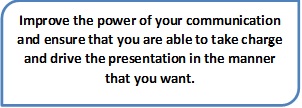Powerful Communication
Presenting to communicate strategy
 While you may be armed with all the essential tools, how are you going to use it to communicate in a manner that you get the kind of response that you expect. At this point let us understand some language patterns that evolved out of Neuro Linguistic Programming that helps you communicate in such a way that you can actually get the response you are looking for. Has it occurred to you that when you watch someone doing a certain action over a period of time you might start to do it too if it appeals to you? This is a form of pacing - an oft used technique to get the listener to slowly move towards agreeing to your point of view (used in sales). Using certain hypnotic language patterns can also help evoke the kind of response you want. Hypnotic language patterns relate to using a choice of words that will direct the listener to respond the way you have directed him to. It is an indirect way of implanting suggestions in the minds of the listener through the choice of words.
While you may be armed with all the essential tools, how are you going to use it to communicate in a manner that you get the kind of response that you expect. At this point let us understand some language patterns that evolved out of Neuro Linguistic Programming that helps you communicate in such a way that you can actually get the response you are looking for. Has it occurred to you that when you watch someone doing a certain action over a period of time you might start to do it too if it appeals to you? This is a form of pacing - an oft used technique to get the listener to slowly move towards agreeing to your point of view (used in sales). Using certain hypnotic language patterns can also help evoke the kind of response you want. Hypnotic language patterns relate to using a choice of words that will direct the listener to respond the way you have directed him to. It is an indirect way of implanting suggestions in the minds of the listener through the choice of words.
Using linguistic tools appropriately can lead you to the response you desire. For instance, using certain words - should or must ( You must remember to write a draft every SINGLE time) is involuntarily received by the listener as a must do, and therefore use of these words to reinforce a point will work with an audience. Additionally, the emphasis on key words also elicits the response that you want. (e.g. SINGLE when emphasized drives home the point that it must be done every time).

Often repetition of words or actions will help to elicit the required response. Relating a concept to an action through association will embed the concept for a long time in the minds of the audience.
Consider such strategies to improve the power of your communication and ensure that you are able to take charge and drive the presentation in the manner that you want.
Am I nervous
 Jitters and stage fright are normal for any presenter. In fact, not feeling any of it would be abnormal. But sometimes our fears get the better of us and make us tongue tied. However panic and anxiety can be worked upon and dispelled. Our fears relate to nervousness - the fear of being judged, a fear of forgetting, and a fear of large audiences.
Jitters and stage fright are normal for any presenter. In fact, not feeling any of it would be abnormal. But sometimes our fears get the better of us and make us tongue tied. However panic and anxiety can be worked upon and dispelled. Our fears relate to nervousness - the fear of being judged, a fear of forgetting, and a fear of large audiences.
Let us first take stock of the emotions you feel when you have to make a presentation.
What happens to your breathing? 
Do you feel cold and sweaty at the same time?
Do your limbs shake?
Do you feel your voice is affected?
Do you feel stressed and unable to think straight?
Before we get on to some practical tips to reduce nervousness let us consider what else you could do.

- Be thoroughly prepared, know the subject content, and in fact, read up extensively so that you know more than what is required.
- Understand your audience
- Be organized, have all your requirements in place.
- Practice as much as you can – videotape yourself if need be and use that to correct yourself.
- Speak loudly so that you feel confident.
Summary:
- Use NLP - an indirect way of implanting suggestions in the minds of the listener through the choice of words.
- Do a video recording to see how well you present.
Copyright (c) Infosys BPO Limited and/or its licensors, 2014, all rights reserved